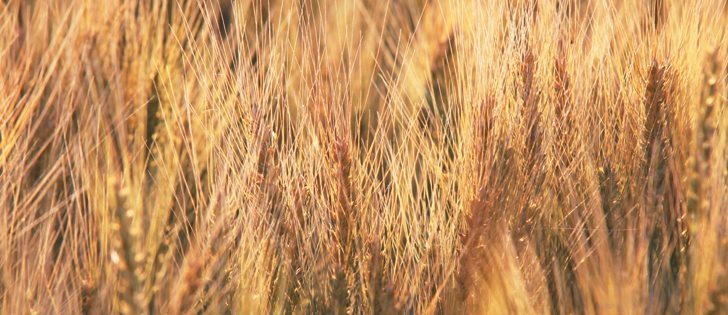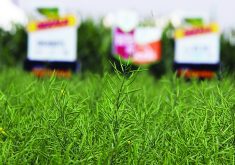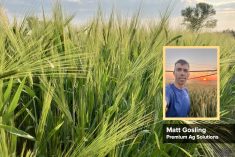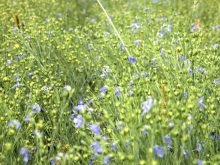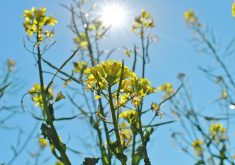Saving half a season | Fall-seeded crop can help growers can pull a rabbit out of their cap
It is estimated that four to five million prairie acres went unseeded this year or were seeded and then flooded.
But don’t write them all off.
“It’s a good opportunity to get winter wheat into the ground and take your profit in 2015,” says Bruce Burnett, CWB’s director of weather and market analysis.
“Where you have accessible fields where you won’t harvest a crop this year, seeding winter wheat this fall almost guarantees you’ll have a crop on that land next year,” he said.
Read Also

Growing garlic by the thousands in Manitoba
Grower holds a planting party day every fall as a crowd gathers to help put 28,000 plants, and sometimes more, into theground
Ducks Unlimited agronomist Ken Gross said a lot of crop won’t be ready to combine until late September, so producers have time now to plant a fall seeded crop on their washed-out fields.
He said this summer was bad for fusarium, and many producers are looking at Emerson, a new variety with a “very good” resistance rating that helps break the fusarium cycle.
Gross said there are things farmers can do to get a winter wheat crop off to a good start.
Winter wheat is normally direct seeded into spring crop stubble, which provides winter protection. Seeding into chemfallow or flooded soil should be done slightly earlier in the recommended seeding window for strong establishment.
The disease is present on many fields this year so delaying seeding where it is present can help avoid spreading it from spring to fall seeded crops.
Newer stripe rust resistant varieties are available. Moats and Pintail are among those for dryland, while Flourish and AAC Gateway are good for irrigated crops and in parkland regions. Radiant is now considered susceptible.
Flourish and Gateway are potential replacements for Falcon. These are short varieties with “select” quality and are suitable for irrigation.
Moats can replace Buteo and Radiant in many areas because of its improved yield, disease resistance and uniformity.
For more information, visit www.growwinterwheat.ca.
A healthy, vigorous crop must be established before winter to achieve maximum cold tolerance, so seeding earlier is better. The ideal is a plant with three leaves that is starting to develop its first tiller.
Seeding from Aug. 25 to Sept. 10 consistently produces the best yield and quality, but crop insurance dates indicate success can be achieved at later dates. In Alberta, these are Sept. 20 north of the Bow River and Sept. 30 south of the river. In Saskatchewan and Manitoba it is Sept. 15.
Research shows that winter wheat benefits from using a seed treatment.
Producers should target a plant population of about 30 plants per sq. foot. Most farmers seed at two bushels per acre, but seed counts per bushel and mortality rates are important to know. Larger seed varieties such as Flourish should be seeded at a rate of 2.5 bu. per acre.
Winter wheat must be seeded shallow at .5 to one inch to allow the plant to emerge quickly and vigorously. It performs better if seeded closer to four m.p.h. rather than six.
Excessive moisture has caused leaching and denitrification, but mineralization may also have occurred on chemfallow acres, so soil testing is recommended.
Winter wheat has the potential to out-yield spring by 15 to 40 percent, but it requires higher rates of fertilizer. Always add phosphate at seeding to ensure strong root and crown development and improve the plant’s ability to survive the winter and re-grow vigorously in the spring.
Some growers have given up on the CWB select varieties because they’ve had trouble hitting the 11 percent protein mark. In most cases, protein missed the mark because growers used spring wheat nitrogen recommendations instead of the higher winter wheat nitrogen rates. Growers who seed select varieties now generally use the higher rates to get the protein bonus.
Winter wheat that receives too much nitrogen at early stages suffers from excessive vegetative growth and lodging. Conversely, head size can suffer if a nitrogen deficiency occurs before stem elongation.
Winter wheat uses 30 to 40 percent of its nitrogen by the five to six leaf stage, or the start of stem elongation. The remaining 60 to 70 percent is used from the start of stem elongation to maturity. Managing nitrogen availability to match those needs is key to a profitable winter wheat crop.
Delayed release nitrogen products can be effective.
Contact Ken Gross at 204-729-3507.




